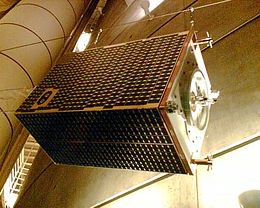Ørsted (satellite)

Model of the Ørsted Satellite in the Tycho Brahe Planetarium
|
|
| Mission type | Earth observation |
|---|---|
| Operator | Danish Meteorological Institute |
| COSPAR ID | 1999-008B |
| SATCAT no. | 25635 |
| Mission duration | 18 years, 3 months and 11 days |
| Spacecraft properties | |
| Manufacturer | Computer Resources International |
| Launch mass | 61 kg (134 lb) |
| Dry mass | 50 kg (110 lb) |
| Dimensions | 34x45x72 cm (and an 8 m boom) |
| Power | 54.0 W (nominal) |
| Start of mission | |
| Launch date | 23 February 1999, 10:29:55 UTC |
| Rocket | Delta II 7920-10 D267 |
| Launch site | Vandenberg SLC-2W |
| Contractor | Boeing |
| Orbital parameters | |
| Reference system | Geocentric |
| Regime |
Low Earth (near–sun synchronous) |
| Semi-major axis | 7,111.179 km (4,418.682 mi) |
| Eccentricity | 0.0141189 |
| Perigee | 632.6 km (393.1 mi) |
| Apogee | 833.4 km (517.9 mi) |
| Inclination | 96.4421 degrees |
| Period | 99.5 minutes |
| RAAN | 173.2395 degrees |
| Argument of perigee | 10.0389 degrees |
| Mean anomaly | 29.8678 degrees |
| Mean motion | 14.477406 |
| Epoch | 14 December 2013, 14:18:37 UTC |
Ørsted is Denmark's first satellite, named after Hans Christian Ørsted (1777–1851) a Danish physicist and professor at the University of Copenhagen. It is in an almost sun synchronous low Earth orbit.
After more than seventeen years in orbit, the Ørsted satellite is still operational, and continues to downlink accurate measurements of the Earth's magnetic field. Ørsted was constructed by a team of Danish space companies, of which CRI was prime contractor. CRI was acquired by Terma A/S before Ørsted was launched, and the daily operations are being run as a teamwork between Terma A/S and the Danish Meteorological Institute.
In 2010, Ørsted passed within 500 meters of debris from the 2009 satellite collision but suffered no damage.
Ørsted was the first in a planned sequence of microsatellites to be flown under the now discontinued Danish Small Satellite Programme.
The main scientific objective of the spacecraft was to map the Earth's magnetic field and collect data to determine the changes occurring in the field.
Based on data from the Ørsted satellite, researchers from Danish Space Research Institute concluded that the Earth's magnetic poles are moving, and that the speed with which they are moving has been increasing for the past few years. This apparent acceleration indicates, that the poles of the Earth might be in the process of switching around, which could have serious consequences for land-based biological life.
The results have been published in several prominent scientific journals, and graced the cover pages of Geophysical Research Letters,Nature, and Eos.
...
Wikipedia
